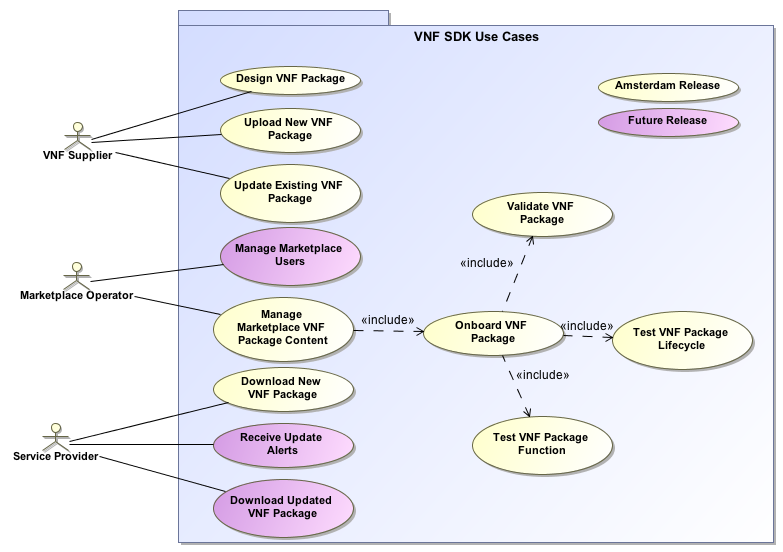USE CASE
| 5G Service Modeling |
BUSINESS DRIVER
This section describes Business Drivers needs.
EXECUTIVE SUMMARY - This requirement introduces platform information model enhancements to document new ISOMII experimental classes from 3GPP TS28.541, the 5G Network Resource Model (NRM).
BUSINESS IMPACT - The requirement, is a critical because it will serve to lay the ground-work for actually "turning on" a real 5G DU (PNF) that might be installed by a Vendor.
BUSINESS MARKETS - This project applies to any domain (wireless, transport, optical, and wireline) that ONAP may manage.
FUNDING/FINANCIAL IMPACTS - Without the groundwork laid down for information model management of a 5G Service, operators will not be able to "turn on" a real live 5G network using "live" PNF resources. No Network. No Business. High OPEX impact.
ORGANIZATION MGMT, SALES STRATEGIES - There is no additional organizational management or sales strategies for this use case outside of a service providers "normal" ONAP deployment and its attendant organizational resources from a service provider.
DEVELOPMENT STATUS
| PROJECT | PTL | User Story / Epic | Requirement |
| A&AI | NO IMPACT | ||
| AAF | NO IMPACT | ||
| APPC | NO IMPACT | ||
| CLAMP | NO IMPACT | ||
| CC-SDK | NO IMPACT | ||
| DCAE | NO IMPACT | ||
| DMaaP | NO IMPACT | ||
| External API | NO IMPACT | ||
| MODELING | EPIC #1 Modeling work to adapt 3GPP TS28.541 NRM | ||
Multi-VIM / Cloud | NO IMPACT | ||
| OOF | NO IMPACT | ||
| POLICY | NO IMPACT | ||
| PORTAL | NO IMPACT | ||
| SDN-C | NO IMPACT | ||
| SDC | NO IMPACT | ||
| SO | NO IMPACT | ||
| VID | NO IMPACT | ||
| VNFRQTS | NO IMPACT | ||
| VNF-SDK | NO IMPACT | ||
| CDS | NO IMPACT |
List of PTLs:Approved Projects
*Each Requirement should be tracked by its own User Story in JIRA
USE CASE DIAGRAM
Use cases define how different users interact with a system under design. Each use case represents an action that may be performed by a user (defined in UML as an Actor with a user persona).
USE CASE FUNCTIONAL DEFINITIONS
Use Case Title | Title of the Use Case |
Actors (and System Components) | The list of Actors and System Components that participate in the Use Case |
Description | Short overview of the Use Case |
Points of Contact | Authors and maintainers of the Use Case. Use Case Lead, Key Use Case members and code contributors. |
Preconditions | A list of conditions that are assumed to be true before the Use Case is invoked Includes description of Information Consumed |
Triggers / Begins when | Describes the trigger for beginning the Use Case |
Steps / Flows (success) | Describes the sequence of steps and interactions that occur during the Use Case (may include: description, data exchanges, functionality, state changes) Interaction diagrams may be included or referenced |
Post-conditions | The expected results of the execution of the Use Case Includes description of Information Produced |
Alternate / Exception Paths | Description of any exceptions or special process that could occur during Use Case |
Related Use Cases | List of the Use Cases referenced by this Use Case |
Assumptions | Describes any assumptions that are made for this use case |
Tools / References / Artifacts | List of any tools or reference material associated with this Use Case as well as any JIRA trace-ability. List of any associated diagrams or modelling artifacts associated with the Use Case |
TESTING
Current Status
Testing Blockers
- High visibility bugs
- Other issues for testing that should be seen at a summary level
- Where possible, always include JIRA links
END TO END FLOW TO BE TESTED
TEST CASES AND STATUS
| 1 | There should be a test case for each item in the sequence diagram | NOT YET TESTED |
| 2 | create additional requirements as needed for each discreet step | COMPLETE |
| 3 | Test cases should cover entire Use Case | PARTIALLY COMPLETE |
| 4 | Test Cases should include enough detail for testing team to implement the test | FAILED |
